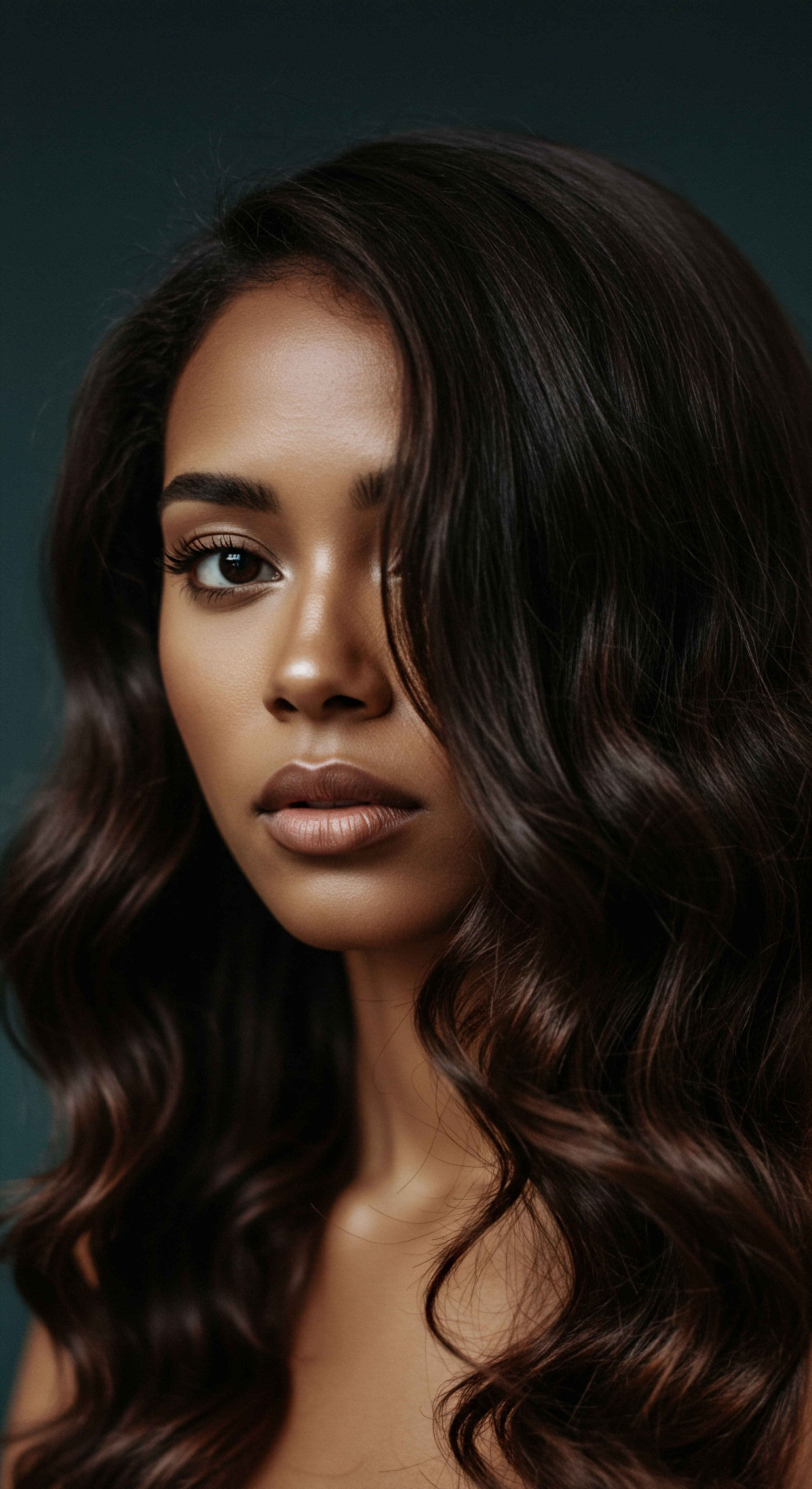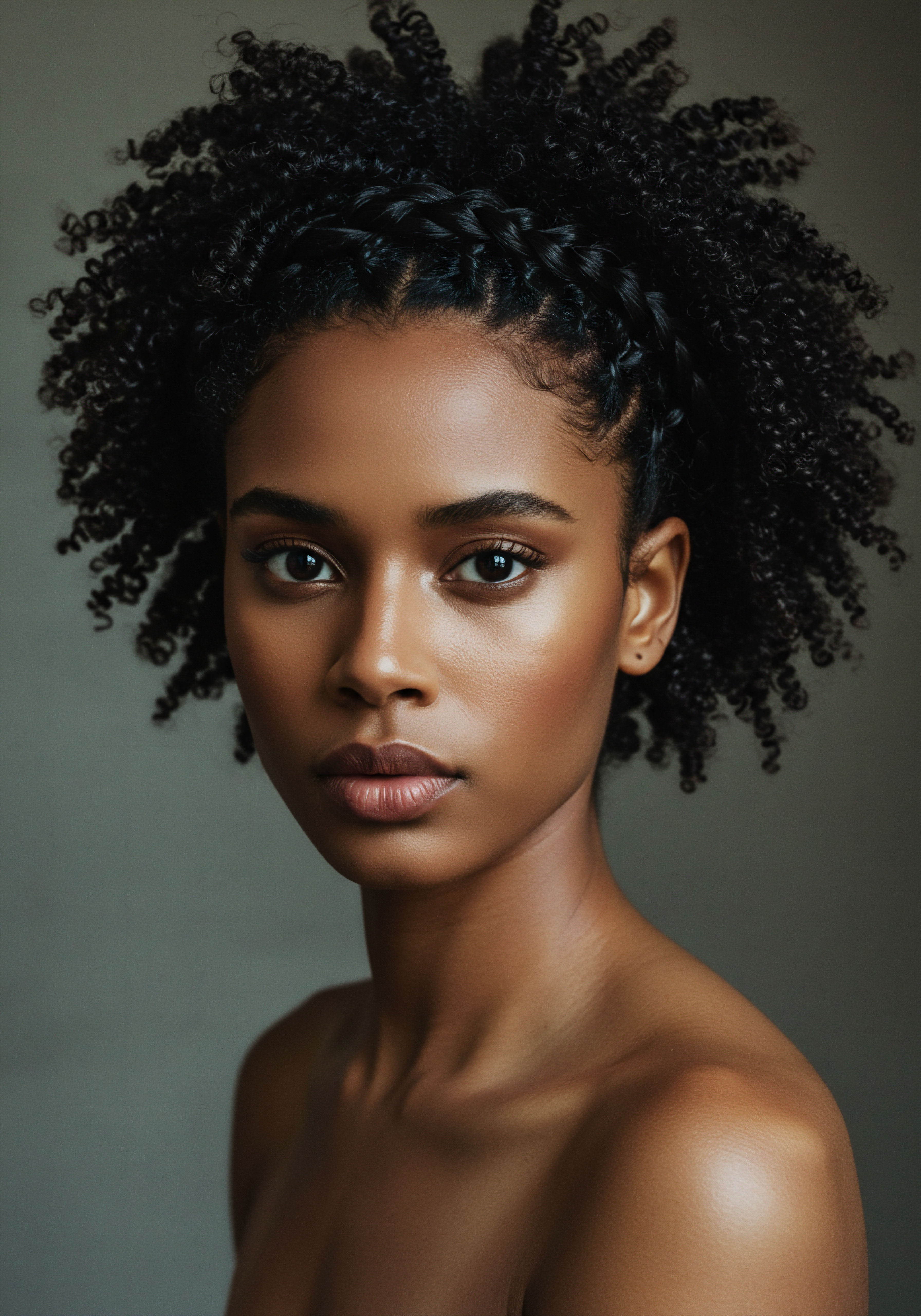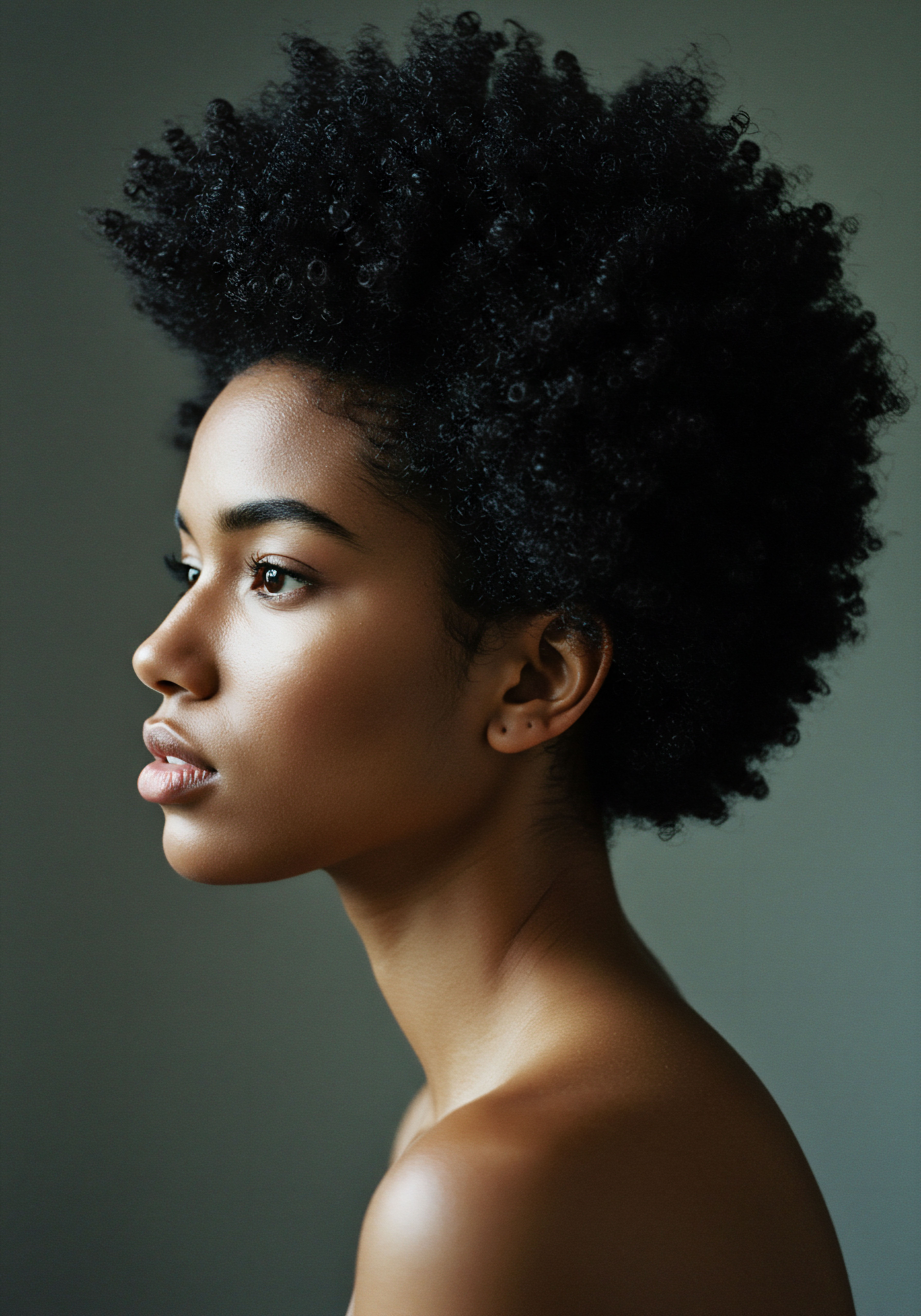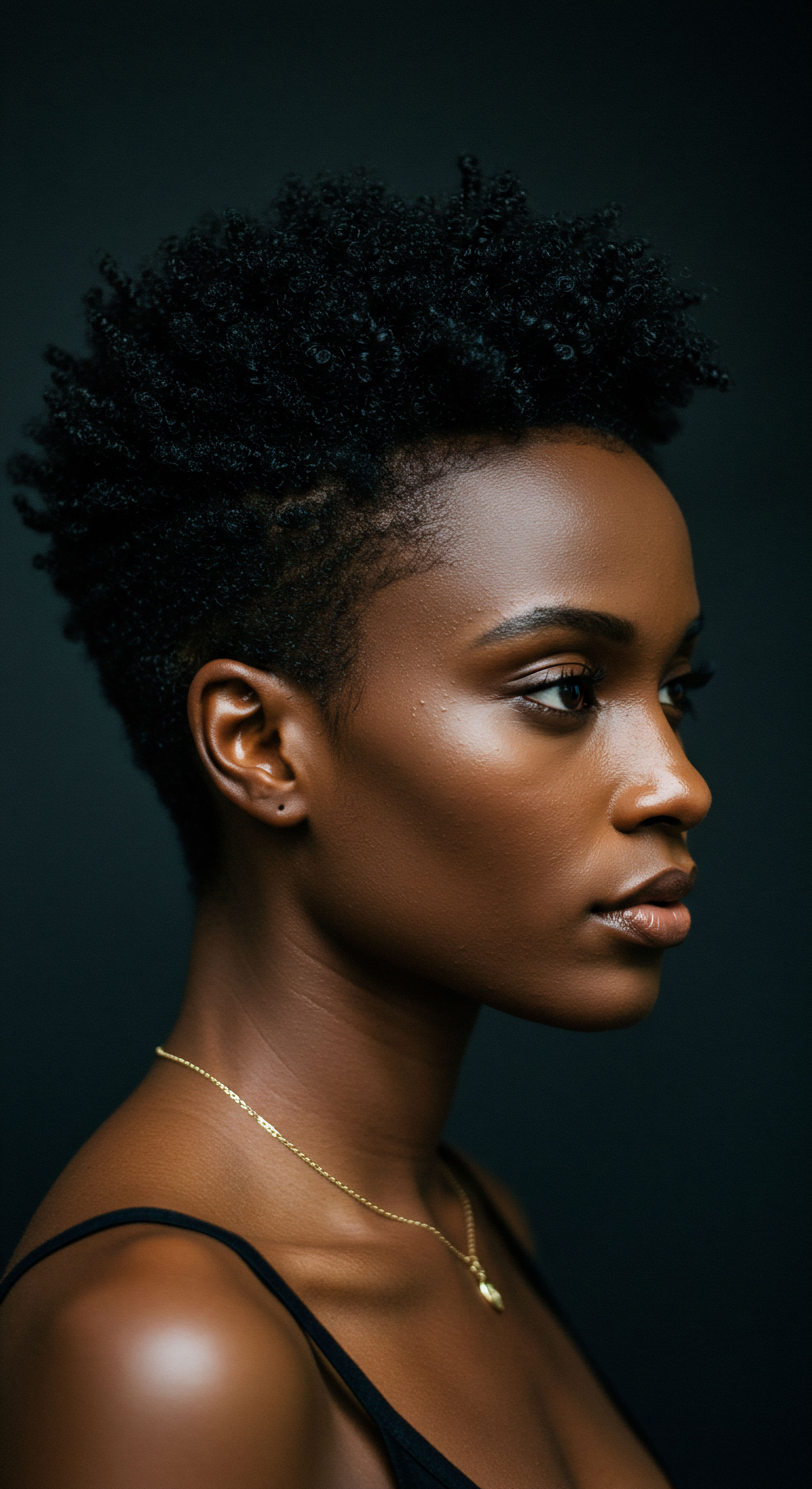
Roots
The very notion of hair, especially the rich and varied forms found across Black and mixed-race heritages, carries with it an intrinsic dialogue between the strand and its surroundings. A quiet observation often begins with a gentle touch, noticing whether a curl feels supple and vibrant, or perhaps a little parched, longing for a quenching touch. This innate sensitivity to a strand’s well-being leads us to ponder ❉ can the practices we adopt, the rhythms we establish in our hair care, truly alter the delicate equilibrium of moisture within each individual fiber? To understand this profound interaction, one must first descend to the foundational elements, tracing the very architecture of a hair strand and the forces that shape its inherent thirst.

The Architecture of a Hair Strand
Each strand, though seemingly simple, is a marvel of biological construction, a complex protein filament extending from the scalp. Its core, the Medulla, often appears only in thicker hair types, serving as a central, sometimes hollow, canal. Surrounding this is the Cortex, the primary bulk of the hair, composed of tightly packed keratin fibers. This is where hair derives its strength, elasticity, and where its natural pigments reside.
The cortex holds the key to a strand’s internal hydration, as water molecules find their home amidst these intricate protein chains. The outermost layer, the Cuticle, functions as a protective shield, a series of overlapping, scale-like cells resembling shingles on a roof. These cuticular scales, when healthy, lie flat, creating a smooth surface that reflects light and, crucially, seals moisture within the cortex. When disrupted, however, these scales lift, creating pathways for moisture to escape and making the hair feel rough or brittle.
The shape of the hair follicle itself dictates the curl pattern, which in turn profoundly influences how moisture behaves. Straight hair follicles are round, producing straight strands with cuticles that lie relatively flat. As the follicle becomes more elliptical or even ribbon-like, the hair strand coils, twists, and turns, leading to waves, curls, and coils. In textured hair, these twists and turns mean that the cuticle does not lie as uniformly flat along the entire length of the strand.
These natural bends create points where the cuticle is inherently more lifted, offering more opportunities for moisture to evaporate. Furthermore, the natural oils produced by the scalp, known as sebum, struggle to travel down the length of a highly coiled strand, leaving the ends particularly vulnerable to dryness.

Textured Hair Classification Systems
While a simple number-and-letter system often attempts to categorize textured hair, it is a starting point, not a definitive map of a strand’s moisture needs. This system, popularized to help consumers identify their curl patterns, typically ranges from 3A to 4C for curly and coily hair types.
- Type 3 Hair ❉ Characterized by distinct S-shaped curls.
- 3A ❉ Large, loose curls, often resembling spirals.
- 3B ❉ Bouncier, tighter curls with a smaller circumference.
- 3C ❉ Tightly packed curls, often the size of a pencil or straw.
- Type 4 Hair ❉ Defined by very tight, often Z-shaped coils, or very tight S-shaped coils.
- 4A ❉ Tightly coiled S-pattern, often the size of a crochet needle.
- 4B ❉ Tighter, Z-shaped coils, often bending at sharp angles.
- 4C ❉ Very tight, often undefined coils, with significant shrinkage.
However, a strand’s moisture balance is not solely determined by its curl pattern. Two individuals with identical 4C hair might experience vastly different moisture retention based on factors such as their hair’s Porosity, density, and even environmental humidity. Porosity, in particular, is a more significant indicator of a strand’s capacity to absorb and hold water.
High porosity hair, with its more open cuticle, readily absorbs moisture but also loses it quickly. Low porosity hair, with a tightly closed cuticle, resists moisture absorption initially but, once hydrated, retains it for longer.
Understanding the inherent structure of a hair strand and its natural tendencies offers a foundational insight into how care practices can influence its hydration.

The Essential Lexicon of Textured Hair
A common language helps us speak with precision about our hair’s needs. Beyond curl types, terms such as Porosity, Elasticity, and Density are vital. Porosity, as discussed, describes the cuticle’s openness.
Elasticity refers to a strand’s ability to stretch and return to its original state without breaking, a sign of good internal hydration. Density refers to the number of individual hair strands on the scalp, which impacts how products spread and how much moisture is needed for adequate coverage.
Consider also the distinction between Hydration and Moisture. Hydration refers to the absorption of water into the hair shaft, while moisture involves both water and emollients (oils, butters) that seal that water in. Many believe that simply applying oil is enough to hydrate hair, yet without water, oils merely sit on the surface, preventing further hydration. This distinction is paramount in formulating effective care methods.

Hair Growth Cycles and Influencing Factors
Hair growth follows a cyclical pattern ❉ the Anagen Phase (growth), the Catagen Phase (transition), and the Telogen Phase (resting). While hair care methods primarily affect the hair once it has emerged from the scalp, the health of the scalp itself, where the follicle resides, significantly impacts the quality of the new growth. A dry, inflamed scalp can produce hair with a compromised cuticle, making it inherently more susceptible to moisture loss.
Internal factors, such as diet, hydration, stress levels, and genetics, also exert a profound influence on a strand’s inherent moisture balance. External factors, including environmental humidity, harsh winds, sun exposure, and pollution, constantly challenge a strand’s ability to maintain its internal water content. The interplay of these internal and external forces means that a static hair care approach often falls short; instead, a dynamic, responsive method is required, one that acknowledges the constant flux of a strand’s environment and its intrinsic needs.

Ritual
Moving beyond the foundational understanding of a hair strand, we turn our attention to the daily and periodic practices that shape its vitality. The careful selection of products, the deliberate execution of techniques, and the rhythmic consistency of a care regimen all contribute to a strand’s moisture equilibrium. This section steps into the realm of practical wisdom, offering guidance on how thoughtful methods can indeed alter a strand’s natural hydration, transforming a dry, brittle feel into a supple, vibrant one. It is in these mindful applications that the potential for change truly manifests.

Protective Styling Encyclopedia
Protective styles serve as a shield, guarding delicate hair strands from environmental aggressors and the constant manipulation that can lead to moisture loss and breakage. These styles minimize exposure to friction, sun, and wind, all of which can strip hair of its natural oils and water. Styles such as braids, twists, buns, and cornrows tuck away the ends of the hair, which are the oldest and most fragile parts of the strand, thus preserving their moisture.
The efficacy of a protective style in preserving moisture hinges on its execution. If braids or twists are too tight, they can cause tension on the scalp and hair follicles, potentially leading to traction alopecia and compromising the hair’s ability to retain moisture in the long run. Conversely, if a protective style is left in for too long without proper cleansing and re-moisturizing, it can become a breeding ground for product buildup and dryness, negating its protective benefits.
Regular cleansing and moisturizing of the scalp and hair, even while in a protective style, are paramount. Mists formulated with water and humectants, followed by a light oil, can be applied to maintain hydration without disrupting the style.
| Style Type Braids (Box Braids, Knotless Braids) |
| Key Benefit for Moisture Seals moisture in, reduces daily manipulation, protects ends. |
| Style Type Twists (Two-Strand, Flat Twists) |
| Key Benefit for Moisture Similar to braids, allows for easier access to scalp for moisturizing. |
| Style Type Buns and Updos |
| Key Benefit for Moisture Tucks away ends, reduces environmental exposure. |
| Style Type Cornrows |
| Key Benefit for Moisture Scalp access for care, minimizes friction for strands. |
| Style Type Choosing the right style and maintaining it properly are vital for moisture retention. |

Natural Styling and Definition Techniques
Beyond protective styles, techniques aimed at defining a strand’s natural curl pattern also play a significant role in moisture preservation. Methods such as the “wash and Go”, which involves cleansing, conditioning, and then allowing curls to air dry with a styling product, rely heavily on product application to seal in water. The success of a wash and go for moisture balance depends on the layering of products ❉ a leave-in conditioner to hydrate, followed by a gel or cream to create a cast that locks in moisture and defines the curl.
The “LOC” or “LCO” method (Liquid, Oil, Cream or Liquid, Cream, Oil) is a popular layering technique designed specifically to optimize moisture retention in textured hair.
- Liquid (L) ❉ This is typically water or a water-based leave-in conditioner, which provides direct hydration to the hair shaft.
- Oil (O) ❉ A light to medium oil is applied next to create a barrier, slowing down water evaporation from the hair.
- Cream (C) ❉ A thicker cream or butter is then used to further seal in the moisture and provide additional conditioning.
The order can be reversed (LCO) depending on hair porosity and preference, with some finding that applying cream before oil yields better results for their particular strand. This methodical layering creates multiple barriers against moisture loss, effectively altering how long a strand remains hydrated.
Intentional product layering, such as the LOC or LCO method, offers a tangible pathway to enhance and maintain a strand’s moisture content.

Wigs and Hair Extensions Mastery
While often seen as styling options, wigs and hair extensions can also serve as a form of protection for the natural hair underneath, thereby influencing its moisture balance. When installed and maintained correctly, they can shield the natural hair from daily manipulation, environmental elements, and excessive heat. However, improper installation, particularly braids that are too tight or extensions that pull on the scalp, can lead to damage and prevent proper access for moisturizing the natural hair.
The care of the hair underneath a wig or extensions is paramount. Regular cleansing of the scalp to remove product buildup and sebum, followed by deep conditioning treatments, helps maintain the natural hair’s hydration. Many individuals neglect their natural hair once it is hidden, but this period offers a prime opportunity to nourish and allow the hair to rest and regain its moisture equilibrium without constant styling interference. Using lightweight, penetrating oils on the scalp and hair underneath can also help to seal in moisture.

Heat Styling and Thermal Reconditioning
The application of heat, while offering versatile styling options, poses the most significant challenge to a strand’s natural moisture balance. High temperatures from flat irons, curling wands, and blow dryers can cause water within the hair shaft to evaporate rapidly, leading to dryness, brittleness, and eventually, structural damage to the cuticle and cortex. This damage makes the hair more porous, further accelerating moisture loss.
Thermal reconditioning, or chemical straightening, uses a combination of chemical solutions and high heat to permanently alter the hair’s disulfide bonds, resulting in straight hair. While achieving a desired aesthetic, this process fundamentally changes the hair’s structure, often making it more susceptible to dryness and breakage due to the severe disruption of the cuticle. Reversing this damage is not possible; the only solution is to grow out the chemically altered hair.
When heat styling is unavoidable, a safety-first approach is vital.
- Lower Temperatures ❉ Utilize the lowest effective heat setting.
- Heat Protectants ❉ Apply a heat protectant product that forms a barrier on the hair, distributing heat more evenly and slowing water evaporation. These products often contain silicones or other polymers that coat the hair shaft.
- Minimal Passes ❉ Reduce the number of passes with heat tools over each section of hair.
- Air Drying First ❉ Whenever possible, allow hair to air dry partially before blow-drying to reduce heat exposure time.
Even with precautions, frequent heat styling will inevitably challenge a strand’s moisture balance, requiring a more intensive hydration regimen to compensate.

The Complete Textured Hair Toolkit
The tools we use are as important as the products and techniques. Wide-tooth combs, detangling brushes designed for textured hair, and microfiber towels are indispensable for preserving moisture.
- Wide-Tooth Combs and Detangling Brushes ❉ These tools minimize breakage during detangling, especially on wet, fragile hair. Breaking fewer strands means more hair to retain moisture.
- Microfiber Towels ❉ Traditional cotton towels can be too abrasive, roughing up the cuticle and leading to frizz and moisture loss. Microfiber towels absorb water gently without disturbing the cuticle, helping to maintain smoothness and seal in hydration.
- Satin or Silk Scarves and Pillowcases ❉ These smooth surfaces reduce friction on the hair while sleeping, preventing moisture absorption by cotton and minimizing cuticle disruption. This is a subtle yet profound shift in daily care that significantly aids moisture retention.
Each tool, when chosen with discernment and used with care, becomes an extension of a thoughtful approach to hair health, collectively contributing to a strand’s sustained moisture.

Relay
Beyond the visible practices and the foundational science, the question of whether changing hair care methods can alter a strand’s natural moisture balance invites a deeper, more reflective inquiry. This segment moves into the interconnectedness of biological predisposition, environmental pressures, and the subtle yet profound influence of our care rituals. Here, we consider the complex interplay, drawing upon scientific observations and challenging common assumptions to paint a comprehensive portrait of hair hydration. The strand is not a static entity; its capacity for moisture is a dynamic dialogue with every choice we make.

Can Hair Learn to Be Less Thirsty
The idea that hair can “learn” to be less thirsty is a compelling concept, often discussed within textured hair communities. While hair itself, being non-living, does not “learn” in a biological sense, its behavior and response to moisture can indeed appear to shift over time due to consistent, targeted care. This perceived change stems from a cumulative effect on the hair’s structural integrity.
When a strand is consistently provided with adequate hydration and sealed effectively, its cuticle layers remain smoother and more intact. This reduced porosity, or rather, the maintenance of a healthy, closed cuticle, means that the hair is more efficient at retaining the moisture it receives.
Consider the impact of cumulative damage. A strand repeatedly exposed to harsh detergents, excessive heat, or aggressive manipulation will inevitably suffer cuticle damage. This damage leads to increased porosity, making the hair feel chronically dry and perpetually “thirsty.” Conversely, a regimen focused on gentle cleansing, deep conditioning, and protective styling reduces this cumulative damage.
Over time, as new, healthier hair grows and existing hair is treated with care, the overall condition of the hair improves, leading to a noticeable difference in its moisture retention. It is less about the hair “learning” and more about the care methods creating an optimal environment for its inherent moisture-holding capabilities to function at their best.

The Microbiome of the Scalp and Hair Hydration
Emerging research points to the intricate relationship between the scalp microbiome and hair health, a factor often overlooked in discussions of moisture balance. The scalp, like the gut, hosts a diverse community of microorganisms. A balanced microbiome, dominated by beneficial bacteria, contributes to a healthy scalp environment, which in turn supports the production of healthy hair. Disruptions to this balance, often caused by harsh shampoos, infrequent cleansing, or excessive product buildup, can lead to conditions like dandruff, irritation, and inflammation.
A compromised scalp environment can indirectly impact hair moisture. An inflamed scalp may produce sebum of a different quality or quantity, or the hair follicle itself may be stressed, producing a strand with a less robust cuticle. For instance, a study published in the International Journal of Trichology noted that imbalances in the scalp microbiome, particularly an overgrowth of certain fungi like Malassezia, can contribute to scalp irritation and subsequent hair issues, including dryness and fragility.
While not directly stating a moisture alteration, it highlights how scalp health, mediated by its microbial inhabitants, lays the groundwork for a strand’s overall well-being, including its capacity for hydration. This suggests that care methods focusing on scalp health, such as using gentle, sulfate-free cleansers and avoiding ingredients that disrupt the microbiome, indirectly contribute to a strand’s ability to maintain its moisture balance.

Challenging the Oil-First Approach for Hydration
A long-held belief in some hair care circles is that applying oil directly to dry hair is the primary way to hydrate it. However, a deeper scientific understanding reveals a more nuanced reality. Oils, while excellent emollients and sealants, do not contain water.
Hair requires water for true hydration. Applying oil to dry hair can create a barrier that prevents water from penetrating the hair shaft, effectively sealing out moisture rather than sealing it in.
The purpose of oil in a moisture regimen is to act as an occlusive, meaning it forms a protective layer on the hair surface, slowing down the rate at which water evaporates from the hair shaft. This is why methods like LOC (Liquid, Oil, Cream) or LCO (Liquid, Cream, Oil) prioritize a water-based product (the “Liquid”) first. The liquid provides the actual hydration, and the oil then helps to retain that hydration.
Changing from an “oil-only” approach to a “water-first, then oil” method fundamentally alters how a strand interacts with moisture, leading to significantly improved and sustained hydration. This shift in method directly influences the strand’s moisture balance by ensuring water is present before being sealed.
The scalp’s unseen microbial community significantly influences hair health, underscoring the interconnectedness of our body’s systems.

The Impact of Water Quality on Hair Hydration
The very water we use to cleanse our hair can subtly yet significantly influence its moisture balance. Hard water, prevalent in many regions, contains a high concentration of dissolved minerals, primarily calcium and magnesium. These minerals can accumulate on the hair shaft, forming a residue that makes the hair feel rough, dull, and can even impede moisture absorption. This mineral buildup can also prevent conditioning agents from effectively penetrating the hair, leaving it feeling dry and brittle even after conditioning.
Conversely, soft water, with its lower mineral content, allows shampoos to lather more effectively and rinses clean without leaving residue. For individuals in hard water areas, changing hair care methods to include chelating shampoos (designed to remove mineral buildup) or installing showerhead filters can make a tangible difference in their hair’s ability to absorb and retain moisture. This often overlooked environmental factor demonstrates how even the most basic element of hair care – water – plays a critical role in a strand’s hydration story.

Genetic Predisposition and Method Adaptation
While care methods can profoundly alter a strand’s moisture balance, it is important to acknowledge the role of genetic predisposition. The inherent structure of a person’s hair follicle, which dictates curl pattern, and genetic factors influencing sebum production and cuticle integrity, set a baseline for a strand’s natural moisture tendencies. For instance, individuals with very tightly coiled hair (Type 4) often have a naturally drier hair type due to the difficulty of sebum traveling down the coiled shaft and the more exposed cuticle at the bends.
This genetic blueprint does not mean one is doomed to perpetually dry hair; rather, it necessitates a more tailored and consistent approach to moisture retention. A person with naturally drier, highly coiled hair may need to cleanse less frequently, deep condition more often, and utilize heavier butters and oils to seal in moisture, compared to someone with looser curls. The alteration in hair care methods, in this context, is not about fundamentally changing the hair’s genetic makeup, but about intelligently adapting practices to optimize its moisture balance within its inherent parameters. This adaptation is a testament to the power of informed choices in working with one’s hair, rather than against it.

Reflection
The journey through the intricate world of hair hydration reveals a truth far richer than a simple cause and effect. A strand’s moisture balance is not a fixed state, but a dynamic equilibrium, constantly responding to the intentionality of our care methods. From the microscopic architecture of the cuticle to the unseen dance of the scalp’s microbiome, every choice – a gentle detangling, a mindful layering of products, a consideration of water quality – contributes to a deeper conversation with our hair. The power to alter a strand’s moisture balance resides not in a singular magic product, but in the consistent, informed, and respectful cultivation of practices that honor its unique nature and heritage.

References
- R. B. G. Rodrigues, et al. “Scalp microbiome in health and disease,” International Journal of Trichology, vol. 12, no. 5, pp. 209-215, 2020.
- Schueller, R. & Romanowski, P. (2017). Conditioning Agents for Hair and Skin. CRC Press.
- Robbins, C. R. (2012). Chemical and Physical Behavior of Human Hair. Springer Science & Business Media.
- Bouillon, C. (2005). Hair Care Products. Marcel Dekker.
- Dias, M. F. R. G. (2015). Hair Cosmetics ❉ An Overview. IntechOpen.
- Marsh, J. M. & Gray, S. (2019). Hair Science ❉ The Hair-Care Handbook. Royal Society of Chemistry.
- Khadi, A. (2019). The Science of Natural Hair ❉ A Guide to the Hair’s Structure, Biology, and Care. Self-Published.